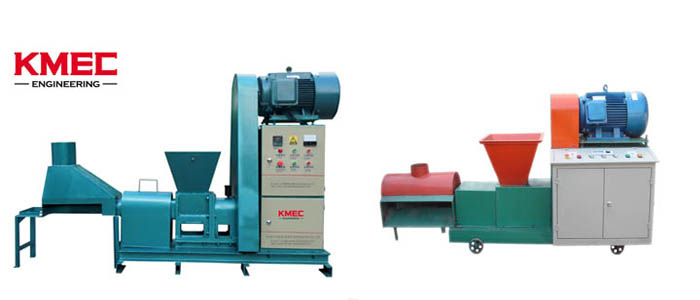Classification of Briquette Machine
Briquetting machine, also called briquette press machine, briquette making machine or briquette maker, is mainly applied to press all kinds of powdery and granular materials into ball shape or other shapes by means of extrusion. Briquette machine can press coal, carbon powder, lime, gypsum, coal slime, metal powder, etc.

Comparing with biomass pellet machine, briquette machine has the advantage of capable of dealing relatively large sized feed stocks with higher moisture content. According to the distinguished application of feedstock, briquette machine can be split into various types such as sawdust briquette machine, rice husk briquetting machine, saw shavings briquette press. Biomass briquettes from briquette machine can be combusted straightforward but under most circumstances, briquette machine is mainly used to offer briquettes to briquettes carbonization, namely to obtain machine-made charcoal due to extended market of charcoal demands but decreasing supply. Briquette machine can handle raw material with water content of less than 15% even 12% and without any use of adding binding agent into material during the process of briquetting. High temperature and high pressure remains the main factors in producing briquettes and they can definitely not neglected. Either of them is less sufficient likely resulting in disqualified briquettes. In particular, we can apparently see a heating coil mounted outside of forming sleeve in this regard. Central hollow of briquettes by screw type briquette machine is the unique character of briquettes which are different from those produced by mechanical stamping briquette machine or hydraulic briquette press. However, all the agricutural waste and wood waste can be put into use yet with different compression ratio within briquette machine.
Screw type briquette press can produce biomass briquettes with very higher compaction, but it also has a very high energy consumption for the process compared to mechanical presses. After feeding, the material is conveyed to the briquette forming head by a revolving screw shaft driven by electrical motor. The screw shaft is the main part of biomass briquette press. The screw distance become smaller and smaller along the screw shaft to briquette forming head. With the decreasing screw distance, the material endures bigger and bigger pressure. Because of the shaft, there is a hole left in the center of biomass briquette column.
In the hydraulic press, the required pressure is produced by the hydraulic system. The specially designed hydraulic cylinder assembly makes the main cylinder release the compressed briquette once the required pressure is reached. The pressure can normally be adjusted via a regulator, which means that all briquettes are compressed under the same pressure. Hydraulic briquette machine adopts the whole set of intelligent hydraulic oil control system. When the temperature of the hydraulic oil is approaching to the high or low temperature limits, the intelligent hydraulic oil control system can automatically turn on or turn off the fan cooling system or the electric heating system to ensure the hydraulic oil at the desirable temperature.
A mechanical press is designed as an eccentric press. A continuously rotating eccentric shaft connected to a plunger presses the raw material through a conic die. In mechanical presses the counter pressure required can only be adjusted by installing a die with a different conicity or different length.
As one of the earliest and largest biomass briquette press manufacturer, you can rest assure that Kingman is capable of offer you the most suitable model of briquette machine to process different materials. If you need biomass briquette machine, please feel free to contact us.

